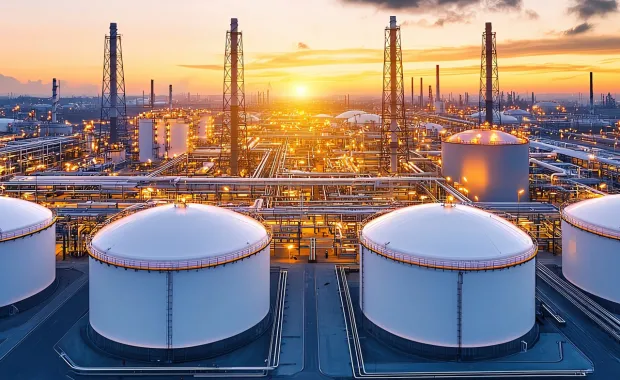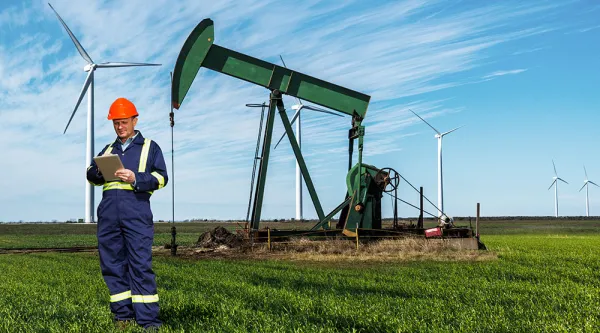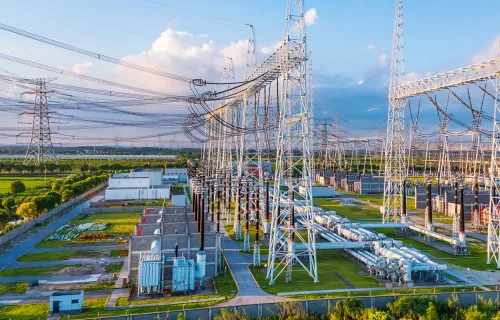Frank highlights four core technologies helping energy organizations boost performance and reduce emissions:
Together, these enablers form a practical foundation for a more efficient and lower-emissions operation.
“ESG strengthens brand reputation, attracts investors and drives innovation.” – Frank Schmidt
Organizations are now embedding ESG into budgeting, product development and stakeholder reporting—positioning it as an asset, not a burden.
Frank points to liquefied natural gas (LNG) as a key area for decarbonization with high long-term value. Operators are gaining emissions and cost advantages through:
Despite the promise of digital ROI, four structural and operational challenges persist:
“These are not small hurdles, but they’re solvable with integrated planning and targeted capability building.” – Frank Schmidt
Digital maturity will define future success. Frank outlines four key areas that are rapidly moving from best practice to baseline:
“Digital twins, smart sourcing, and ESG integration are becoming the norm—delivering lower cost, reduced emissions, and resilience.” – Frank Schmidt
To lead in the energy transition while unlocking business value, organizations should:
LNG operators can gain significant value through waste-heat recovery, renewable integration and real-time optimization via digital twins.
Tracking the right KPIs—such as cost per MWh, team productivity and emissions per asset—ensures digital initiatives are not only deployed but measured for impact. In the race to net-zero, digital isn’t just an enabler—it’s the accelerator.
- 1. Introduction
-
Angelina Bakshi
Welcome and thanks for joining our Energy Transition Talks. On today's episode, we are going to be talking about accelerating net-zero digital pathways that deliver return on investments and cost savings. My name is Angelina Bakshi and I am a business consultant with CGI, located in Western Canada. It's a pleasure for me to introduce my colleague today, Frank.
Frank Schmidt
Thanks, Angelina, many thanks for the introduction and setting the scene. My name is Frank Schmidt, as you rightly said, Vice-President for the global energy sector within CGI. And from that perspective, I support one of our largest clients that we have worked with for over 30 years in the oil and gas sector. I also support several other energy and oil and gas clients around the globe.
- 2. The drivers of digital transformation in oil and gas
-
Angelina Bakshi
Great. Well, I’m excited to have you on the podcast today. We’re going to be talking about net-zero investing in low carbon infrastructure and integrating energy systems. So, we’ll be discussing what the digital pathways are that deliver return on investments and cost savings regarding the race to net-zero—a topic that many oil and gas companies around the world are grappling with, curious about and getting different types of pressures about. One of the first questions right off the bat is what's driving the digital shift?
Frank Schmidt
Yeah, if you talk about the digital moves and reduction of costs, we see a few things happening. The first is the migration to public cloud platforms. If you perform a migration, you see that we can reduce 6% on the energy consumption and even over 90% when you compare it to traditional data center usage.
Another trend that you see is AI-powered predictive maintenance. So, using AI to anticipate equipment failures, for instance, reduces downtime, energy waste and unnecessary resource use.
Another element that you see is the use of smart energy systems. So, for instance, using sensors and analytics to optimize energy usage in real time, which lowers cost and carbon footprints. And the last one I would like to call is digital workflows. And CGI, when it comes to our oil and gas clients, is a long-term partner in the subservice and well space where you traditionally have geoscience and engineering specialists and we can support them faster by using, for instance, low-code platforms and digitalization of the workflows. And that's what we do for several of our clients.
- 3. Evolving ESG from compliance to competitive advantage
-
Angelina Bakshi
A very cool, very interesting time in the industry. So how are leaders moving from compliance to opportunity? Some things are maybe being forced upon them, some things they're doing because they see the opportunity. How are we moving around?
Frank Schmidt
That’s a good question and it's really relevant. I see two main drivers. One is the integration of ESG operating models. If you look at the ESG goals, they are increasingly embedded into budgeting, for instance, product development and performance metrics across departments.
And another driver I see is that leaders are moving also to the value side and use ESG as an innovation tool and a means to strengthen brand equity. Think for instance about biodegradable packaging or circular business models that will enhance your reputation as a company, and it will also attract new talent and investors to your company. So, in short, ESG is becoming not only a source of work, but also a competitive advantage and not just compliance.
- 4. LNG as a high-return digital and decarbonization opportunity
-
Angelina Bakshi
Where do you think along the value chain are the fastest return on investment opportunities?
Frank Schmidt
Well, you see a lot. But if I zoom in to where the global oil and gas market is focusing currently, let's take LNG as an example. LNG is often seen as a bridge or an intermediate source fuel in the energy transition and offers several high returns on investment opportunities across the value chain.
Let me take you through a couple of them.
In the value chain and in oil and gas, you see a lot of focus on LNG. LNG is seen as a bridge, an intermediate source of fuel in the energy transition. And it offers therefore high returns on investment because it's an integral part of our energy demand. The first thing I would like to mention on the LNG side is waste heat recovery. So, capturing and reusing heat during liquefaction improves energy efficiency and lowers operational costs.
A second one in the LNG area is renewable integration. For instance, if you use solar or wind to power an LNG facility, you will reduce carbon footprint and align with regulatory incentive.
And the last technology that you see in the sector is digital twin technology. So, with that, you can simulate LNG operations, which helps you to identify inefficiencies and optimize the performance in real time.
- 5. How cloud, AI and data solutions deliver measurable impact
-
Angelina Bakshi
Very interesting. You mentioned efficiencies in real time—that takes me into the domain of how AI and data and cloud solutions generate quantifiable measurements and impact for these decarbonization projects and intermediate renewable technologies.
Frank Schmidt
Absolutely, it's really seen a boost the last year. Take for instance, cloud, if you migrate your IT infrastructure to cloud data centers, and in addition powered by renewables, you can cut IT related emissions by over 90%. If you take for instance, AI and machine learning, the tooling will optimize energy use, predict equipment failure, for instance, and streamline operations. And you can uncover up to 40% of emissions reductions if you use AI and machine learning.
- 6. Reducing emissions while optimizing OPEX and asset performance
-
Angelina Bakshi
So you're saying that this both cuts the emissions, but I'm hearing from you that we're also seeing some operating cost optimization or even potential capital investments. Is that correct? Explain a little bit more about what you are seeing from use cases that you've seen so far?
Frank Schmidt
Absolutely.
Yeah, if you look at the OPEX, for instance and the emission cutting side of things. For example, predictive maintenance—the use of IoT sensors within assets and within the field and overlaying that with AI models—you can forecast equipment failures much better. That minimizes your downtime and that automatically reduces your OPEX and the reliability of an asset.
Reliability and security in oil and gas is a major factor. Another one I see is smart grid optimization. The use of AI driven grid management, for instance, improves your load balancing and reduces outage, which enhances your energy efficiency usage and that translates into lower emissions and operational costs.
- 7. Four major barriers to digital transformation
-
Angelina Bakshi
Really interesting stuff that's happening. I guess the question that remains is, what's holding oil and gas companies back?
Frank Schmidt
I would say I would like to mention four main blockers, main themes if you wish. I think first, institutional silos. And what I mean by that is that different parts of the energy systems, for instance, grid operators, regulators, utilities operate under fragmented authorities. That's, I think, the main driver.
The second one I would like to mention is system complexity. If you look at decarbonization—its involving infrastructure, supply chains, social systems and the lack of integrated planning tools and real-time feedback loops make it very hard in that ecosystem to optimize across sectors.
A third one: political polarization. Climate policies face uneven support across regions, delaying adoption and creating uncertainty for investors and planners. And the last one that I see within our client set is also skill gap. So if I look at many of our energy clients, they lack the technical expertise to implement and scale clean technology. And sustainability roles often require cross-disciplinary knowledge, engineering and data science, which is in short supply currently.
- 8. Short-term priorities to balance cost, risk and emissions
-
Angelina Bakshi
Those are some significant barriers and areas to try and tackle for any organization. So if you had to take a step back and say, within the next three to five years, which really in the oil and gas timeline is short, it's really in the near term, what are the areas that could best balance cost control and decarbonization impact, in your opinion? Like where should a company start?
Frank Schmidt
I think that energy companies with mature AI strategies, they are doubling down on automation to cut OPEX and boost productivity, even amid the economic uncertainty that we face today. An important example is the use of digital twins. These virtual models of operations, for instance, within LNG terminals, grids, rigs, buildings, allow for real-time monitoring, emissions modeling and scenario planning and that enables smart or lower cost decisions. Another key consideration is how do you source? So smart sourcing and vendor consolidation. Also, if you infuse that with AI and supply chain optimization, it is a means to reduce waste and improve resilience. In that sense, globally, oil and gas companies partner to share risk and to share investment on the long term. The last one I would like to mention is the integration of ESG platforms. We see cloud-based systems for tracking scope 1, 2 and 3 emissions and compliance becoming the standard, and that reduces reporting costs and improves transparency.
Angelina Bakshi
I think that concludes our time today. I really appreciate having you on this podcast and thanks so much.
Frank Schmidt
Many thanks for having me and have a great rest of your day.








